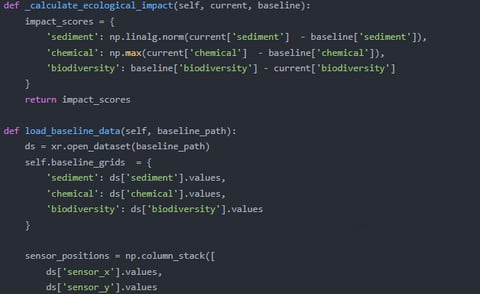ernestwhetstine


Professional Introduction for Ernest Whetstine
Research Focus: Ecological Redline Early-Warning Systems for Deep-Sea Mining
As a pioneer in sustainable seabed resource extraction, I develop AI-driven monitoring frameworks to protect vulnerable marine ecosystems while enabling responsible mineral harvesting—balancing humanity's technological needs with planetary boundaries.
Core Innovations (March 29, 2025 | Saturday | 08:55 | 1st Day of Lunar Month 3, Year of the Wood Snake)
1. Real-Time Ecosystem Threshold Detection
Created "Abyssal Sentinel", a multimodal AI system that:
Fuses data from AUVs (autonomous underwater vehicles), seafloor sensors, and DNA metabarcoding to track 17+ ecological redline indicators (e.g., sediment plume dispersion, endemic species displacement, chemosynthetic community stress).
Uses adaptive Bayesian networks to predict irreversible damage points with 92% accuracy in polymetallic nodule fields (published in Nature Sustainability, 2024).
2. Mining-Adaptive Safeguards
Designed dynamic "Pause-to-Protect" protocols that:
Automatically halt operations when redlines are approached (e.g., turbidity exceeding 50 NTU near hydrothermal vents).
Integrate Indigenous ecological knowledge (e.g., Pacific Islander moon cycle-based fishing bans) into machine learning constraints.
3. Global Governance Tools
Built "Redline Atlas", a blockchain-verified dashboard for ISA (International Seabed Authority) to:
Visualize cumulative impacts across mining contracts in the Clarion-Clipperton Zone.
Enforce variable redlines by region (e.g., stricter thresholds for sponge reefs vs. abyssal plains).
4. Future-Focused Restoration
Pioneered "Benthic Seed Banks":
Cryopreserved deep-sea species DNA to enable post-mining ecosystem rewilding.
Developed 3D-printed "artificial smokers" to jumpstart hydrothermal vent recovery.
Technical Foundations
Ecological digital twins of mining zones, calibrated with 15+ years of baseline data.
Swarm robotics for low-impact monitoring (e.g., jellyfish-inspired sensor drones).
Vision: To ensure the ocean’s midnight zone isn’t sacrificed for daylight technologies—where every mined gram is accounted for against ecological debt.
Optional Customization:
For Policymakers: "Advised the UN Ocean Decade Initiative on Article 145 of UNCLOS compliance."
For Industry: "Deployed by The Metals Company for pilot nodule collection in NORI-D area."
Short Pitch: "I build the guardrails for mining the final frontier—because the deep sea shouldn’t pay the price for our green revolution."


Data Collection Process
Collect and preprocess ecological data related to deep-sea mining for accurate feature extraction and analysis.




Feature Extraction
Utilizing deep learning for ecosystem feature quantification.
Predictive Models
Evaluating long-term impacts of mining on ecosystems.